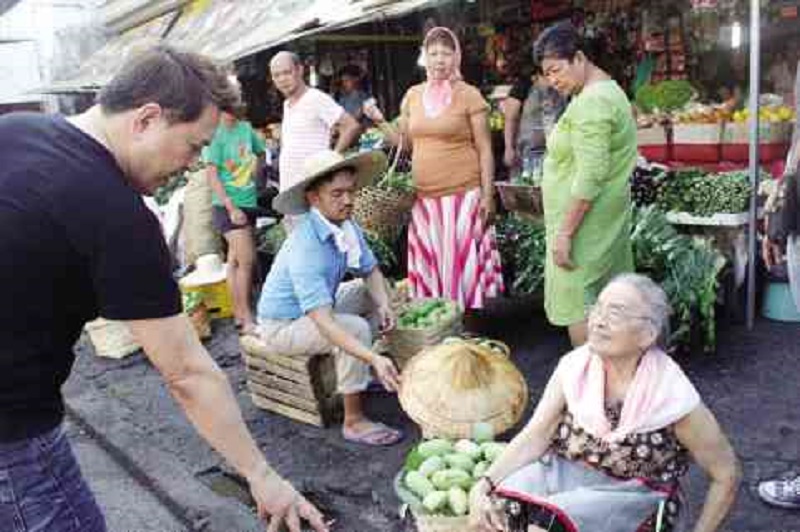Brillante on the heart of Amorsolo’s art
Although their styles and aesthetics are worlds apart, filmmaker Brillante Ma. Mendoza was inexplicably drawn to the work of painter Fernando Amorsolo.
Mendoza was commissioned by the National Gallery Singapore to join four other award-winning directors from Southeast Asia in an omnibus film titled “Art Through Our Eyes.”
The idea was for each filmmaker to come up with “a short film inspired by a piece of art from their country.”
The project gathers an all-star lineup of Cannes winners and other festival favorites. Apart from Mendoza, the other directors in the project are Apichatpong Weerasethakul (Thailand), Eric Khoo (Singapore), Ho Yuhang (Malaysia) and Joko Anwar (Indonesia).
To prepare for the omnibus film, Mendoza visited the National Gallery Singapore and was instantly attracted to Amorsolo’s “Marketplace During the Occupation.” Made in 1942, Amorsolo’s painting is now part of the museum’s extensive collection of Asian art.
Article continues after this advertisementWhile Mendoza’s films are dark, gritty dramas set in the urban jungle, Amorsolo’s body of work is the exact opposite, often depicting vibrant, sun-kissed rural reveries.
Article continues after this advertisementBut the contrast is precisely what intrigues Mendoza about Amorsolo’s art. “It looks festive, even though it’s set during wartime. The colors are bright and warm; the mood, cheerful.”
In a way, he explained, “Amorsolo’s painting captures the Filipino spirit” in a nutshell. “Even in times of adversity, we remain positive and hopeful.”
For his five-minute short film, titled “Amorsolo’s Dream,” he comes up with a modern retelling of the same narrative.
“It’s set decades after the Japanese occupation,” he pointed out. Instead of a world war, the conflict this time involves the local polls.
“We shot the film during the national election last May,” he recounted.
Mendoza and his team filmed an actual miting de avance and staged their own campaign sorties, as well.
Veteran actress Rustica Carpio, who was in the cast of Mendoza’s films “Lola” (2009) and “Captive” (2012), plays a market vendor in “Amorsolo’s Dream.”
He is currently neck-deep in postproduction for the short film, which is set to debut at the Busan International Film Festival in South Korea from Oct. 6 to 15. Mendoza will present two films he directed (“Ma’ Rosa” and “Amorsolo’s Dream”) and two films he produced (Raymund Gutierrez’s “Imago” and Ato Bautista’s “Expressway”) at this year’s Busan fest.
“Art Through Our Eyes” is Mendoza’s second omnibus film this year. Mendoza is also part of “Reflections,” which features works by Isao Yukisada (Japan) and Kulikar Sotho (Cambodia).
“Reflections” was made under the auspices of the Japan Foundation and Tokyo International Film Festival. His contribution to “Reflections” is the 30-minute film, “Shiniuma (Dead Horse),” the story of an undocumented worker (Lou Veloso) who was deported back to the Philippines after years of living in Japan.
Even though he tackles potentially controversial issues (poverty and politics in “Amorsolo’s Dream” and migration in “Shiniuma”), he pointed out that organizations like the National Gallery Singapore, Japan Foundation and Tokyo fest did not interfere in the filmmaking process.
“I was given complete creative freedom. The organizers didn’t meddle at all. They have huge respect for filmmakers,” he said.
“Reflections” will premiere at this year’s Tokyo fest, set from Oct. 25 to Nov. 3 in Japan.
Before “Reflections” and “Art Through Our Eyes,” Mendoza was part of another omnibus film, “Quattro Hong Kong 2,” in 2011. He contributed the short, “Purple,” to “Quattro 2,” produced by the Hong Kong International Film Festival Society. In “Quattro,” Mendoza’s work was showcased alongside those of other Southeast Asian filmmakers: Weerasethakul, Yuhang and Stanley Kwan (Hong Kong).
He noted that representing the Philippines in these omnibus projects is “a big honor that comes with a bigger responsibility.”
“We have to do right by it. That is why I am very careful in choosing the topics of my films. I want to make sure that it will inspire our countrymen, especially young aspiring filmmakers,” he remarked. “We also have a duty to tell the truth, so the world would know the real situation of the country.”
